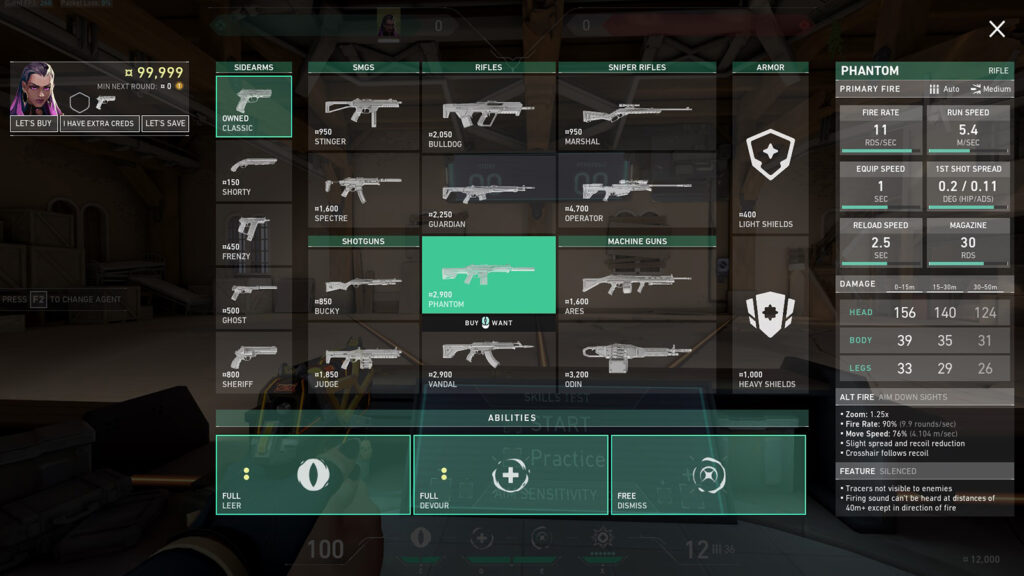Updated on November 24, 12:30 p.m. (GMT+8): Updated the guide for relevancy based on the most recent Valorant patch notes.
As a tactical shooter, Valorant requires a lot more than just good aim and knowing how to use your abilities. There’s an entire sub-game built around understanding the game’s economy to maximize your team’s potential.
In this guide, we’ll give you a breakdown of the Valorant economy and how to use your understanding of it to help your team achieve victory:
Valorant Economics 101
Let’s start with the basics. The economy of Valorant revolves around credits, which you can use to buy weapons, shields, and their purchasable abilities. There are four ways you can earn credits in the game:
The first is by taking down enemy agents, with each kill giving you 200 credits.
Second is by planting the spike, which gives each player on the attacking team 300 credits. While defusing the spike as the defending team will win you the round, it will not grant you any bonus credits for doing so.
The third way is by winning a round, with each player from the winning team getting 3,000 credits.
The last way to earn credits is by losing a round, with all the players from the losing team getting a base 1,900 credits after each loss. Valorant also borrows Counter-Strike: Global Offensive’s round loss bonus mechanic, which gives bonus credits to the team that loses consecutive rounds.
After losing their second round in a row, the losing team will receive a bonus of 500 credits to the base amount they earn after every loss. That amounts to 2,400 credits earned for the second consecutive round lost.
After losing their third round in a row and for every round lost onwards, the losing team will receive bonus 1,000 credits to the base amount they earn after every loss. That amounts to 2,900 credits for the third consecutive round lost and onwards.
Keep in mind that the round loss bonus counter resets after the losing team finally wins a round. This means that if you win a round after you received 2,900 credits for losing three or more consecutive rounds, then the next round you lose will give you the base 1,900 credits for a lost round.
What to buy
Now that you know how to get credits, let’s look at what you can buy with them. At the start of each round, you can open up the ‘Buy Menu’ with ‘B’ to purchase weapons, shields, and two of your agent’s purchasable abilities.
Here’s a list of the weapons and armor that you can buy and how much they cost:

Sidearms
- Classic – Free
- Shorty – 150
- Frenzy – 450
- Ghost – 500
- Sheriff – 800
SMGS
- Stinger – 950
- Spectre – 1,600
Rifles
- Bulldog – 2,050
- Guardian – 2,250
- Phantom – 2,900
- Vandal – 2,900
Shotguns
- Bucky – 850
- Judge – 1,850
Sniper
- Marshal – 950
- Operator – 4,700
Heavy
- Ares – 1,600
- Odin – 3,200
Shields
- Light – 400
- Heavy – 1,000
As for your agent’s purchasable abilities, each character has different prices per ability. Keep in mind that you keep your abilities even after you die on most agents, so it’s generally a good idea to invest in them early as they will usually provide some much-needed utility for your team.
How to best spend your credits
Pistol rounds

Your economy for much of each half of every game will be determined by the pistol round, which happens in Round 1 and Round 13, as the team that wins the pistol round usually wins the next round as well.
You’ll have 800 credits for the pistol round, and it’s usually best to spend 500 credits on the Ghost pistol. The weapon is a huge help in winning the pistol round, as it’s highly accurate, does a lot of damage with a falloff starting at 30m, and will one-shot headshot anyone without armor at 30m or less.
If you do end up winning the pistol round, you’ll get over 3,000 credits to spend for the next round. You can then use that to buy armor, abilities, and better weapons to help your team start snowballing.
If you trust your aim, then a strong setup would be to get the Bulldog rifle along with heavy armor, assuming you had at least 100 credits saved up from the pistol round.
Alternatively, go for either the Phantom or Vandal assault rifles, both of which cost 2,900 credits. Both are excellent mid-range rifles with good scopes, high damage, and reasonable recoil. The Phantom is a little more forgiving, especially if you’re not too confident with headshots, but the Vandal does more damage per shot and can actually one-shot headshot a fully armored target at almost any range.
Full buys
A ‘full buy’ refers to when you fully kit yourself out with a rifle or a sniper, heavy armor, and all your purchasable abilities. This means that you will be at your strongest, though it will cost you approximately 4,500 credits or more.
To be able to get enough credits for a full buy, your team would have to either win two consecutive rounds or lose three consecutive rounds when accounting for both spending and saving between each round.
Should you always full buy?
No, you should not spend all of the credits you have at the start of every round. While getting everything that you can to help you win a round seems like a good call at first, sometimes it’s better to save up and give your team a better chance at winning with a better kit in the next round.
To know whether it’s a good time to go for a full buy or not, then check your team’s economy first. If you see that all or most of your teammates have enough credits for a full buy, then go for it. If not, then it’s probably best to go ‘eco’ or save your credits for the next round.
For example, one of the most common situations, when you can do a full buy, is after winning three rounds in a row. In that scenario, your team should be at its strongest while the other team likely wouldn’t have enough credits to match your kits.
If you don’t have enough credits to buy something you can request it and one of your teammates can opt to spend their credits for you.
Things to remember
Check the scoreboard at the start of each round to see the economy of the enemy team and base what you buy around that. For example, if you see the enemy team has no credits then they might go for a rush with pistols or SMGs to make the most out of what little they have.
Always keep an eye on the top left corner of the Buy Menu to see the minimum amount of credits you’ll have for the next round.
Use up all your credits on Rounds 12 and 24, since whatever credits you may have from these rounds won’t carry over to the side switch or potential overtime rounds.
On Overtime or Round 25, all players will have 5,000 credits but no abilities will be charged. While that is enough for a full buy, there will be situations when you won’t be able to have all of your purchasable abilities ready.
READ MORE: Beginner’s Guide to Valorant: Tips and strategies everyone should know


